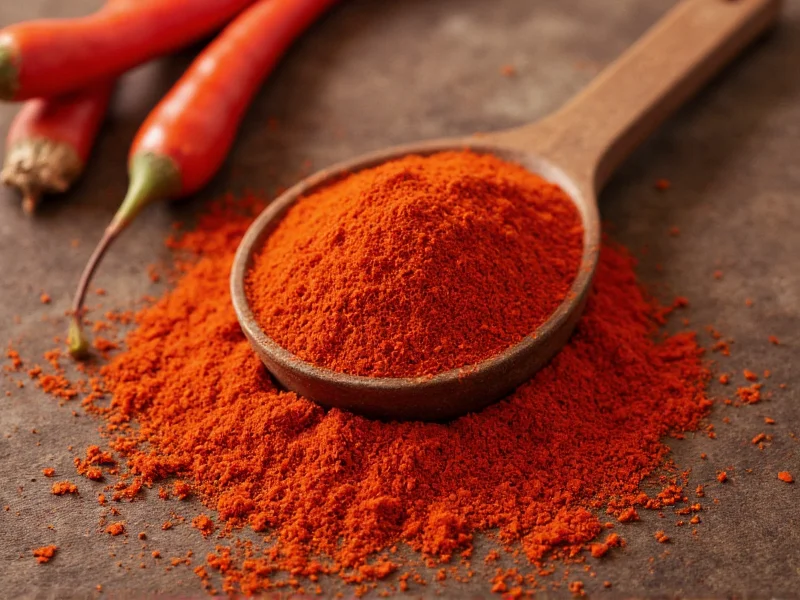Many home cooks mistakenly treat crushed red pepper and cayenne pepper as identical ingredients, potentially altering the flavor profile and heat intensity of their dishes. This confusion stems from similar appearances and overlapping uses in cooking, but significant differences exist in composition, heat level, and culinary applications.
Composition and Ingredients
Crushed red pepper, often labeled as "red pepper flakes" in stores, typically consists of a mixture of dried and crushed chili peppers. While formulations vary by brand, most commercial crushed red pepper contains a blend of cayenne peppers along with other red chili varieties like serrano, jalapeño, and sometimes even bell peppers. The specific blend affects both flavor and heat level.
In contrast, pure cayenne pepper is made exclusively from ground cayenne peppers (Capsicum annuum var. annuum). This single-ingredient spice delivers a more consistent heat profile and distinctive flavor. When checking labels, authentic cayenne pepper should list only "cayenne pepper" or "ground cayenne" as the ingredient.
Heat Level Comparison
The heat difference between these spices significantly impacts recipe outcomes. Understanding Scoville Heat Units (SHU) helps clarify why substitution requires caution:
| Spice Type | Scoville Heat Units (SHU) | Relative Heat Level |
|---|---|---|
| Pure Cayenne Pepper | 30,000-50,000 SHU | Consistently hot |
| Crushed Red Pepper | 500-22,000 SHU | Variable heat (mild to medium) |
Because crushed red pepper contains multiple pepper varieties, its heat level varies considerably between brands and batches. Some crushed red pepper blends might contain only mild peppers, while others include hotter varieties. Pure cayenne delivers reliable, consistent heat that's approximately 2-3 times hotter than typical crushed red pepper.
Flavor Profiles and Culinary Applications
These spices offer distinct flavor characteristics that affect dish outcomes:
- Cayenne pepper provides a sharp, immediate heat with subtle fruity notes and earthy undertones. Its fine powder consistency distributes evenly through dishes, making it ideal for sauces, rubs, and spice blends where uniform heat distribution matters.
- Crushed red pepper delivers a more complex flavor profile with varying degrees of smokiness depending on the pepper blend. The visible flakes add texture to dishes and provide intermittent bursts of heat. This makes it perfect for finishing pizzas, sprinkling on pasta, or incorporating into olive oil for dipping.
Substitution Guidelines for Home Cooks
Understanding when you can substitute crushed red pepper for cayenne prevents recipe disasters:
When Substitution Works
- For dishes where precise heat control isn't critical (like hearty stews or chili)
- When using crushed red pepper to finish a dish rather than incorporate during cooking
- In recipes calling for small amounts (less than 1/4 teaspoon)
When to Avoid Substitution
- In recipes requiring consistent heat distribution (like baked goods or smooth sauces)
- When precise heat measurement matters (such as in competitive cooking)
- For individuals with specific heat tolerance requirements
If substituting crushed red pepper for cayenne, use approximately 1.5-2 times the amount of crushed red pepper to achieve similar heat levels. Conversely, when replacing crushed red pepper with cayenne, use about half the amount to avoid overwhelming heat.
Common Misconceptions Clarified
Several persistent myths confuse home cooks about crushed red pepper vs cayenne pepper differences:
- Myth: Crushed red pepper is just coarsely ground cayenne
Reality: Crushed red pepper typically contains multiple pepper varieties, not just cayenne - Myth: All red pepper flakes are equally hot
Reality: Heat levels vary significantly between brands and batches - Myth: Cayenne pepper and red pepper flakes can always be used interchangeably
Reality: Substitution requires careful adjustment due to heat and texture differences
Practical Tips for Using These Spices
Maximize flavor and heat control with these professional techniques:
- Taste before using: Sample a tiny amount of crushed red pepper to gauge its heat level before adding to recipes
- Bloom spices: For cayenne pepper, briefly cook in oil to mellow the heat and enhance flavor complexity
- Layer heat: Use cayenne for base heat and crushed red pepper for finishing to create dimensional spiciness
- Storage matters: Keep both spices in airtight containers away from light to preserve potency for up to 1 year
Reading Spice Labels Effectively
When shopping for these ingredients, check labels carefully to understand what you're purchasing:
- Look for "100% cayenne pepper" for pure cayenne
- Examine crushed red pepper ingredient lists for specific pepper varieties
- Check for additives like salt, anti-caking agents, or other spices
- Consider regional variations (Italian-style crushed red pepper differs from generic blends)











 浙公网安备
33010002000092号
浙公网安备
33010002000092号 浙B2-20120091-4
浙B2-20120091-4